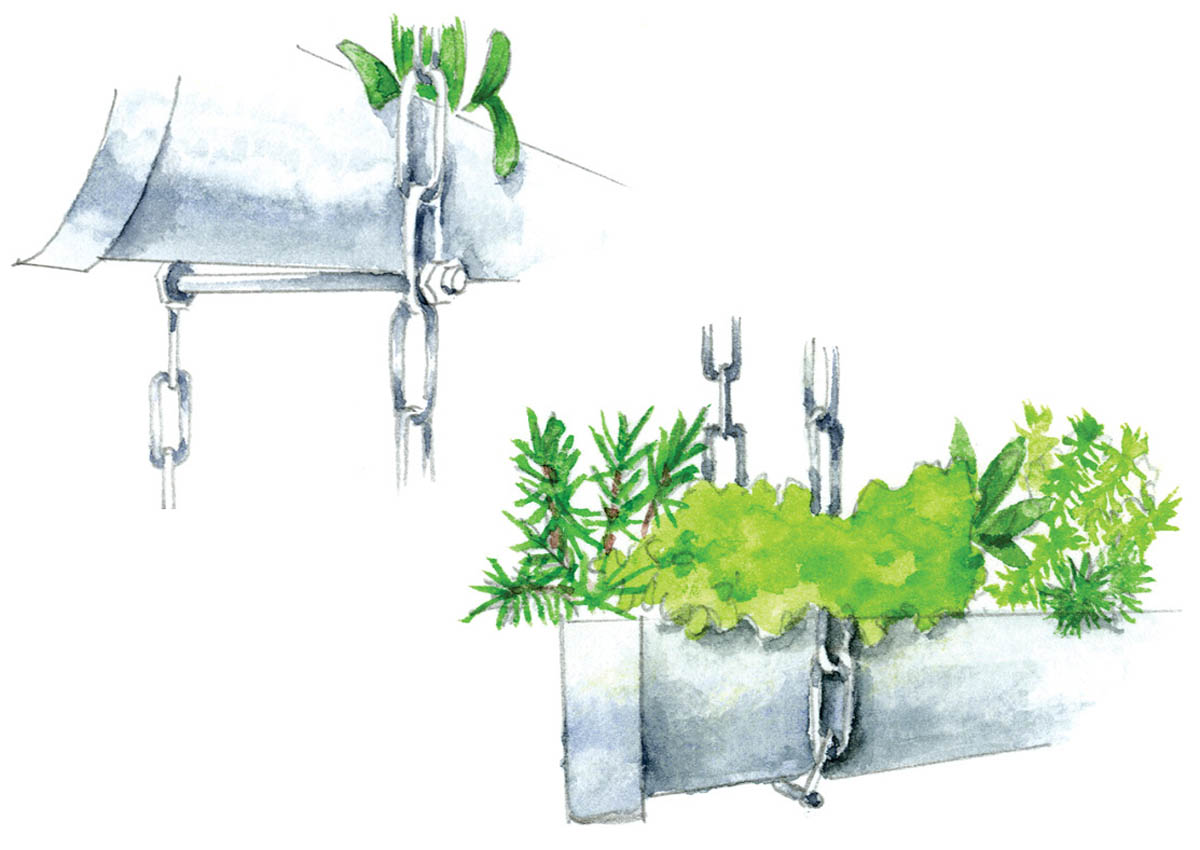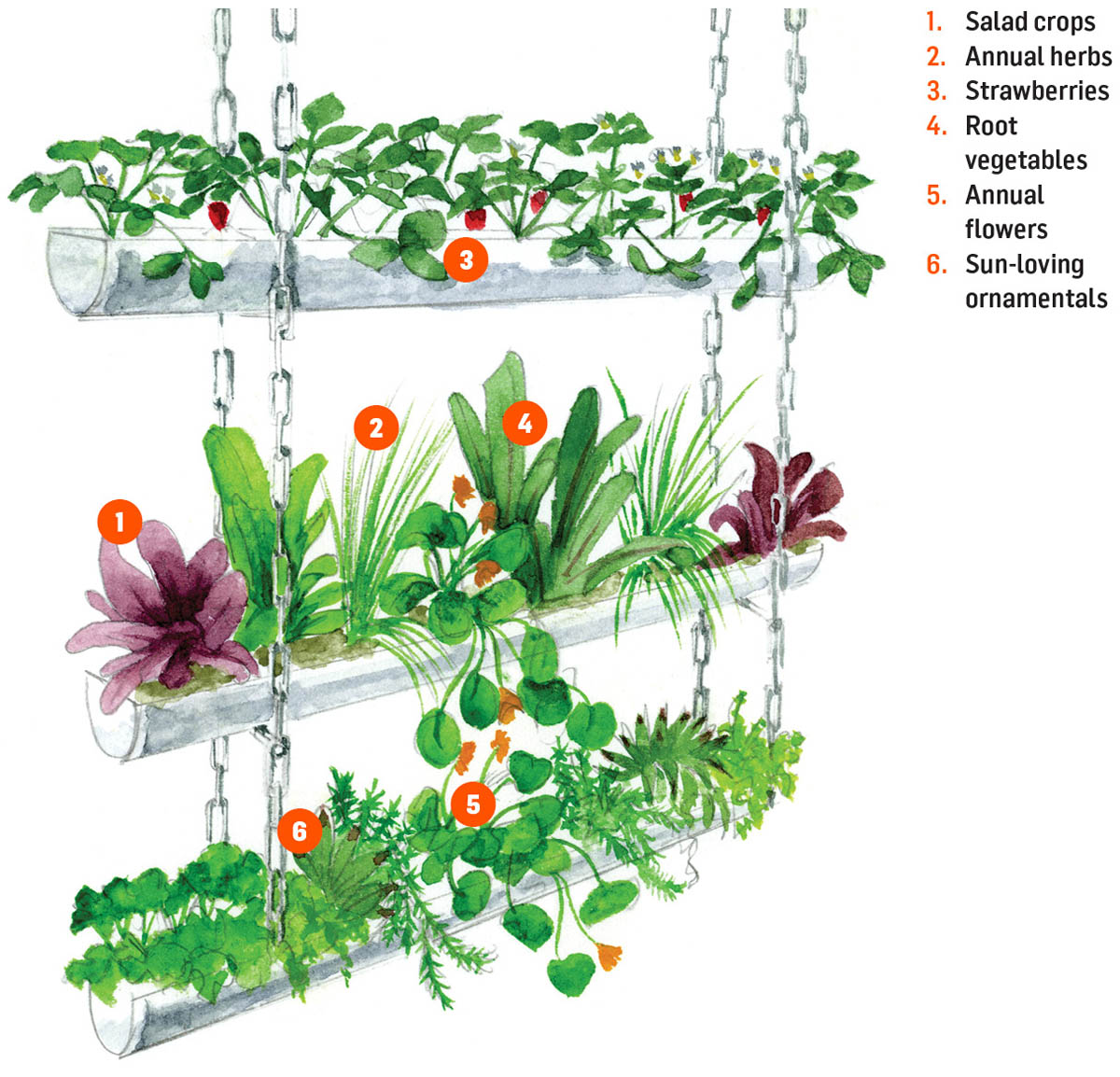Jayme Jenkins’s Hanging Gutters
No garden? No problem! With her design for a gutter garden, Jayme Jenkins proves that as long as you have a bit of sun, virtually any empty space can be used to grow food. “Gutter gardens are a great way to take advantage of the vertical spaces around your home to grow flowers and edibles, and create a stylish space divider or privacy screen without spending too much money,” says Jayme.
- An easy way to turn an empty vertical space into an attractive edible screen
- Uses inexpensive or recycled gutters
- Can be customized to fit any sized space
- Ideal for compact crops such as leaf lettuce, parsley, or strawberries
Need more convincing? Just Google “gutter garden” and you’ll find dozens of photos of gutters planted with compact vegetables such as leaf lettuce and baby spinach, herbs, and edible flowers. Gutter gardens are typically mounted on the side of a house, garage, or fence, but Jayme was reluctant to drill holes in the siding of her house; instead, she came up with the idea of a gutter garden that hangs from the roof of her front porch.
Jayme notes that gutter gardens are an attractive alternative to potted gardens, which can take up a lot of space and look cluttered. “This project is perfect for small-space gardens like balconies, or just to add visual interest to an otherwise boring patio,” she says.
Protect your veggies. Gardeners weary of battling slugs, deer, voles, or rabbits will also appreciate that a hanging gutter garden keeps your tender lettuce and herbs safe from hungry critters. No more chewed leaves!
Water often. As with any container garden, you will need to water your hanging gutters much more often than in-ground crops. Water every couple of days, or as needed; a drip irrigation system will make watering much easier. Jayme recommends using a watering can with a narrow spout so that water hits the soil, not the plants. In such a small space, plants will quickly use up the nutrients in the soil, so give your gutter garden an occasional dose of a liquid organic food to keep food production high and your ornamental plants healthy.
Threaded Rods
Stainless steel threaded rods support the top two layers of gutters, while the chain is just looped under the bottom gutter. Have your hardware store cut the threaded rods slightly wider than the gutter. The rods should be just wide enough so that, when the bolts are threaded, the gutter fits snugly between the chains.
“Let the hardware employee know that you need to be able to thread the bolts on and off the threaded rod,” advises Jayme. If you will cut the threaded rod yourself, screw on the bolts before you make the cuts; otherwise you won’t be able to screw them on.
Jayme’s Hanging Gutters
Jayme suggests sticking to shallow-rooted edibles and annual flowers. As plants are harvested or production declines, replace them with fresh seedlings.
1. Salad crops: Arugula, spinach, pak choi, Swiss chard, kale (harvest and remove before plants reach full size), and all kinds of lettuce
2. Annual herbs: Cilantro, curly parsley, chives, thyme, rosemary, oregano
3. Strawberries: Jayme recommends buying bare-root plants to save money and make planting easier
4. Root vegetables: Baby beets, ‘Easter Egg’ radishes, and short carrot varieties like ‘Tonda di Parigi’
5. Annual flowers: Marigolds, sweet alyssum, nasturtiums, pansies, and violas
6. Sun-loving ornamentals: Sedums, portulaca (purslane), and mecardonia
How to Build a Three-Tier Hanging Gutter Garden
These instructions are for a three-tier, 32-inch-long hanging gutter garden. For longer gutters or hangers, modify the materials accordingly. Jayme used zinc-plated chains, which will eventually rust, adding another design element to the gutter garden, but if you prefer shiny steel, go for galvanized chains.
Materials
- 1 8-foot length of white gutter (PVC or other material) cut into three 32-inch sections (or longer lengths)
- 6 white gutter end caps
- 2 chains, cut to desired length. These are sold by the foot in hardware and building supply stores.
- 4 1⁄8-inch stainless steel threaded rods (to support the gutters)
- 8 bolts (to be threaded onto the rods)
- 2 galvanized J-hooks
- Potting soil and plants
Tools
- Cordless drill with drill bit set
- Handsaw or hacksaw
- T-square or straightedge
- Tape measure
- Pencil or grease pencil
- Eye protection (always a good idea when working with tools)
Instructions
- 1. Determine the center of each of the gutters; draw a reference line down the inside using your T-square to make the line straight. “This is to make sure your drainage holes are in a straight line, since the top levels will be visible from the bottom,” says Jayme, explaining that it just looks better when the holes are even.
- 2. Using a 3⁄16-inch drill bit, drill holes every few inches in the bottom of the gutters to make sure you provide good drainage. (Plant roots hate sitting in water for long periods of time.)
- 3. Locate a spot that gets at least 4 hours of sun. “I placed mine on the crossbeams of a pergola, but you could also hang it off a deck, balcony, or even the facia board on the eaves of your house,” notes Jayme.
- 4. Measure in about 4 inches from the ends of your gutters and mark the corresponding positions on your support of choice. Drill pilot holes: “This is a hole slightly smaller in diameter than the screw's threads, which makes screwing in the J-hook a lot easier,” she says.
- 5. Determine how far you want your gutter garden to hang down. Multiply that length by two to determine the length of chain you will need to hang one end of your garden. Using the handsaw, cut two pieces of chain to this length. Make sure each chain has the same number of links. (This is where elementary school math comes in handy!)
- 6. Loop the ends of one chain through the first J-hook, then loop the ends of the second chain through the second J-hook.
- 7. Cap the ends of your gutters, then fill with potting soil and plant them with succulents, shallow-rooted edibles, or — my favorite — strawberries!
- 8. Have a helper pull apart one hanging chain as you insert one end of the first gutter through the bottom of the chain loop, leaving about 4 inches of gutter extending beyond the chain support. Insert the other end through the other chain loop so it extends an equal distance beyond the chain.
- 9. Determine the mature height of your first gutter's plants, then insert a threaded rod through two chain links that are just higher than the eventual tops of the plants. Repeat for the other chain, making sure you insert the second rod at the same height as your first. (You can count the number of chain links from the bottom.)
- 10. Thread a nut on each end of the two metal rods. Tighten just enough to keep the gutter in place.
- 11. Repeat steps 8, 9, and 10 for your third gutter.

